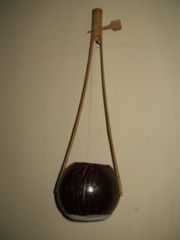
OK, so I’m probably not the first to think of that pun but I could not resist. Monisha and I made a side trip to Shantiniketan, the rural retreat founded by Nobel-prize winning poet Rabinranath Tagore. It is a wonderful break from the Kolkata chaos. I was a bit disappointed as far as my quest for original and edgy music because the biggest original music event of the year was taking place the day we left and we could not make it.
I was not expecting any consolation from the home of the poet but we were in for a treat. While there, we had several encounters with Bauls, mendicant mystics of Bengal who follow a way of life based on the pursuit of divine madness or frenzy. They mix elements from Tantra, Sufi Islam, Vaishnavism and Buddhism into a practice based in the body with the goal of reaching a union with the divine on earth through love.
The earliest textual traces of the Bauls date back to the fifteenth century although some posit a relationship to Persian Ba’als, wandering minstrels who can be documented as far back as the eighth century. They interpret the lack of documents as an indifference to leaving anything behind, and when I interviewed Binod Das Baul, he said the sect was as old as time. At any rate, by the mid eighteenth century it was well documented as a major sect. Baulism was probably in part an answer against the inroads made by Christianity and Islam into Bengal. Membership is by initiation and one must be of the right temperament to even be considered by a guru. Once in, it seems they live on donations for their singing and playing. There is a Baul festival every year, and Bauls come from all over. It has a bit of a reputation, as one of the things they are known for is their ganja use, which I can witness to (but of which I did not partake). Apparently a lot of city guys go to the Baul festival in mid-January, the Jaidev Kenduli Mela, to get high. It is supposed to be a pickpocket’s paradise, with lots of city dwellers involuntarily donating their wallets, too stoned to notice the absence or care.

The Bauls sing and play instruments associated with their way of life. The most common is the one-stringed ektara, which acts more like a drum. It is designed along the lines of a tiny washtub bass. A string passes through the inside of a gourd resonator and is attached to a tuning peg at the end of a piece of carved bamboo acting as a neck. The bamboo is cut so that two thin, flexible pieces surround the string before terminating at the top of the gourd. You pluck the string rhythmically and squeeze the two bamboo pieces to lower the note. There is a variation on this favored by the musicians we heard which dispenses with the bamboo neck altogether. The singer holds the gourd under one arm and the string with a metal or stone ball at the end is pulled taut with the hand of the same arm. The string is plucked with a pick made of water buffalo horn held in the free hand. Another common Baul instrument is a four-stringed lute with no frets played by pressing the fingers on the neck like a guitar or violin. They also use a two-headed drum, the khol, sort of like a set of tablas attached end to end and played on the lap. Bells attached to their ankles jangle in time to round out the sound. In indoor settings, harmonium is often used as a drone and melody instrument. The introduction of this latter instrument made it so Baul songs began to be in set keys rather than set to the singer’s voice.
The singing is ecstatic, reminding me of Sufi music. Our first encounter was at a market called the Haat and a Baul group led by singer Tarun Khyapa had set up shop and were singing and playing. As they were playing, another group of three Bauls, all dressed in orange like the first, arrived on a single motorcycle, instruments and all. This caused a moment of consternation among the first group, but they recovered and began a new piece, in which Khyapa declares he has not found the mad person he longs for. This is funny as his last name (which is an honorific) means “crazy” in the sense of divine frenzy. The desired one is left ambiguous so it could be a lover’s or the divine madness he wants. Toward the end, you can hear a sharp upward swing in the effusiveness and energy. That was right after I dropped a tip in the hat and bought their CD. The iPhone recording quality was accidentally set to low for this one so it is not so good sound. In addition, the crickets in this and the next piece are overbearingly loud even after I equalized them out as best I could.
Tarun Khyapa and Co.
Tarun and company had reason for concern. The second group of Bauls, led by singer Lakshman Das Baul really got the instruments and singing rocking. Just watch out for that ambassador car that nearly drove through them while leaving. Lakshman’s voice gets tangled up with the instruments as the whole ball of music got worked into a multilayered frenzy with voice, string, and percussion all beautifully interleaved. Give it a listen. I bought CDs from both musicians, but the CDs are much more polished and less ecstatic than the live recordings.
I had an encounter with another Baul a few days later which I’ll write about in its own post, as I have to sort through over an hour’s worth of recordings.
